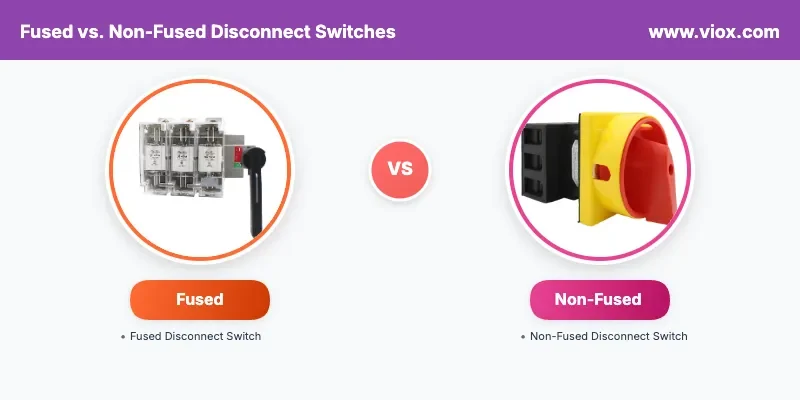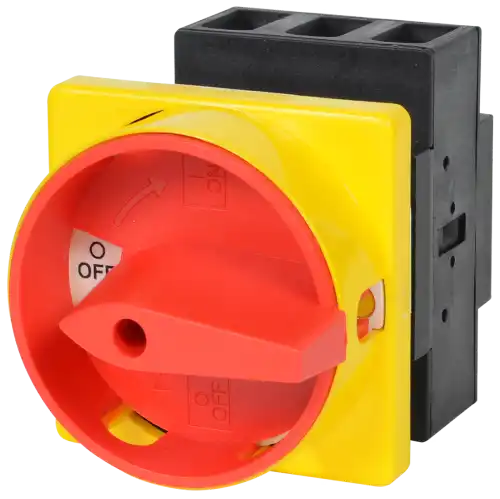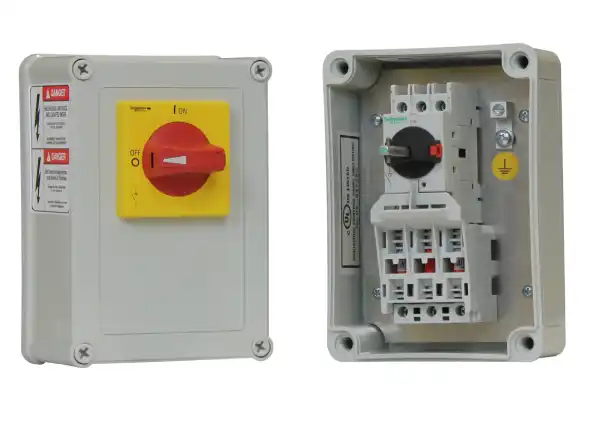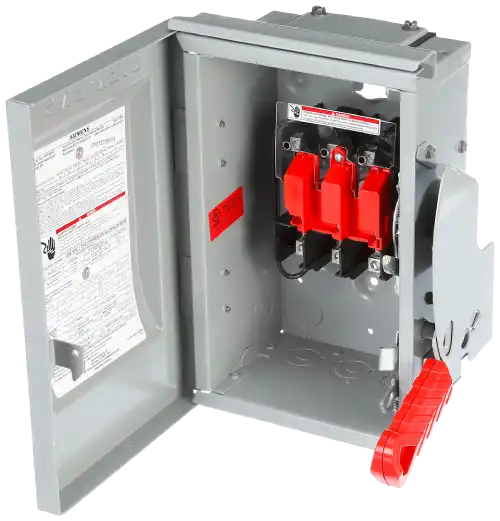ໃນແຕ່ລະປີ, ເຫດການໄຟຟ້າເຮັດໃຫ້ເກີດການບາດເຈັບໃນບ່ອນເຮັດວຽກຫຼາຍພັນຄົນ ແລະຄວາມລົ້ມເຫຼວຂອງອຸປະກອນ - ຫຼາຍໆຢ່າງສາມາດປ້ອງກັນໄດ້ດ້ວຍການເລືອກສະວິດການເຊື່ອມຕໍ່ທີ່ຖືກຕ້ອງ. ບໍ່ວ່າທ່ານກໍາລັງຕິດຕັ້ງລະບົບຄວບຄຸມມໍເຕີໃຫມ່ຫຼືການຍົກລະດັບອຸປະກອນຄວາມປອດໄພຂອງສະຖານທີ່, ຄວາມເຂົ້າໃຈຄວາມແຕກຕ່າງລະຫວ່າງປຸ່ມຕັດການເຊື່ອມຕໍ່ແບບຟິວກັບ fused ແລະບໍ່ fused ສາມາດຫມາຍຄວາມວ່າຄວາມແຕກຕ່າງລະຫວ່າງການດໍາເນີນງານທີ່ປອດໄພ, ສອດຄ່ອງແລະການຢຸດງານທີ່ມີຄ່າໃຊ້ຈ່າຍ.
ແຖວລຸ່ມຂຶ້ນດ້ານໜ້າ: ສະຫວິດຕັດການເຊື່ອມຕໍ່ fused ສະຫນອງການປ້ອງກັນ overcurrent ໃນຕົວໂດຍຜ່ານ fuses ປະສົມປະສານ, ໃນຂະນະທີ່ສະຫຼັບຕັດການເຊື່ອມຕໍ່ທີ່ບໍ່ແມ່ນ fused ພຽງແຕ່ isolate circuits ໂດຍບໍ່ມີການສະຫນອງການປົກປ້ອງເພີ່ມເຕີມ. ການເລືອກຂອງທ່ານແມ່ນຂຶ້ນກັບລະບົບປ້ອງກັນທີ່ມີຢູ່ແລ້ວ, ຄວາມອ່ອນໄຫວຂອງອຸປະກອນ, ແລະຄວາມຕ້ອງການສະເພາະຂອງຄໍາຮ້ອງສະຫມັກ.
Disconnect Switches ແມ່ນຫຍັງ? (ເຂົ້າໃຈພື້ນຖານ)
ສະຫຼັບຕັດການເຊື່ອມຕໍ່, ເຊິ່ງເອີ້ນກັນວ່າສະວິດຄວາມປອດໄພ ຫຼື ສະວິດໂດດດ່ຽວ, ແມ່ນອຸປະກອນຄູ່ມືທີ່ອອກແບບມາເພື່ອຕັດໄຟຟ້າອອກຈາກວົງຈອນ ຫຼື ຊິ້ນສ່ວນຂອງອຸປະກອນ. ສະວິດເຫຼົ່ານີ້ເຮັດຫນ້າທີ່ເປັນກົນໄກຄວາມປອດໄພຕົ້ນຕໍທີ່ອະນຸຍາດໃຫ້ພະນັກງານບໍາລຸງຮັກສາໃຫ້ບໍລິການອຸປະກອນໄຟຟ້າໂດຍບໍ່ມີຄວາມສ່ຽງຕໍ່ການໄຟຟ້າຫຼືຄວາມເສຍຫາຍອຸປະກອນ.
ຈຸດປະສົງພື້ນຖານຂອງສະຫຼັບຕັດການເຊື່ອມຕໍ່ໃດຫນຶ່ງແມ່ນເພື່ອສ້າງຊ່ອງຫວ່າງທາງດ້ານຮ່າງກາຍໃນວົງຈອນໄຟຟ້າ, ການຮັບປະກັນວ່າບໍ່ມີກະແສໄຫລໄປຫາອຸປະກອນລຸ່ມນ້ໍາ. ການໂດດດ່ຽວນີ້ແມ່ນສໍາຄັນຕໍ່ຂັ້ນຕອນການປິດ/ tagout (LOTO) ແລະການປະຕິບັດຕາມກົດລະບຽບຄວາມປອດໄພໃນບ່ອນເຮັດວຽກ.
ສະພາບລວມຄວາມຕ້ອງການ NEC
ອີງຕາມ NEC ມາດຕາ 430.102B, disconnect switches ຕ້ອງຕັ້ງຢູ່ "ໃນ sight" ຈາກ motors ແລະອຸປະກອນການຜະລິດທັງຫມົດ. ລະຫັດໄຟຟ້າແຫ່ງຊາດກໍານົດ "ໃນສາຍຕາ" ເປັນທີ່ເຫັນໄດ້ແລະບໍ່ເກີນ 50 ຟຸດຈາກອຸປະກອນຄວບຄຸມ. ຄວາມຕ້ອງການນີ້ຮັບປະກັນວ່າພະນັກງານບໍາລຸງຮັກສາສາມາດຕັດສາຍໄຟໄດ້ໄວແລະປອດໄພໃນເວລາທີ່ຈໍາເປັນ.
Fused Disconnect Switches ອະທິບາຍ
ວິທີການປິດການເຊື່ອມຕໍ່ Fused Disconnect ເຮັດວຽກ
ປຸ່ມຕັດການເຊື່ອມຕໍ່ Fused ສົມທົບສອງຫນ້າທີ່ທີ່ສໍາຄັນໃນ enclosure ດຽວ: ການແຍກວົງຈອນແລະການປ້ອງກັນ overcurrent. ອຸປະກອນເຫຼົ່ານີ້ປະກອບດ້ວຍຟິວທີ່ຈະລະເບີດ (ເປີດ) ເມື່ອກະແສໄຟຟ້າເກີນລະດັບທີ່ປອດໄພ, ປົກປ້ອງທັງວົງຈອນແລະອຸປະກອນທີ່ເຊື່ອມຕໍ່ຈາກຄວາມເສຍຫາຍ.
ໃນເວລາທີ່ການ overload ຫຼືວົງຈອນສັ້ນເກີດຂຶ້ນ, ອົງປະກອບຂອງຟິວ melts, ສ້າງວົງຈອນເປີດທີ່ຢຸດເຊົາການໄຫຼຂອງປະຈຸບັນ. ການທໍາງານສອງອັນນີ້ເຮັດໃຫ້ສະວິດການເຊື່ອມຕໍ່ fused disconnect ທີ່ມີຄຸນຄ່າໂດຍສະເພາະໃນຄໍາຮ້ອງສະຫມັກທີ່ມີຄວາມຈໍາເປັນການປົກປ້ອງວົງຈອນເພີ່ມເຕີມເກີນສິ່ງທີ່ສະຫນອງໃຫ້ຢູ່ໃນແຜງຕົ້ນຕໍ.
ຄຸນນະສົມບັດທີ່ສໍາຄັນຂອງສະວິດການຕັດການເຊື່ອມຕໍ່ Fused
- ການປົກປ້ອງກະແສໄຟຟ້າໃນຕົວ: ຟິວທີ່ປະສົມປະສານໃຫ້ການປົກປ້ອງທັນທີຕໍ່ກັບຄວາມຜິດທາງໄຟຟ້າ, ມັກຈະປະຕິກິລິຍາໄວກວ່າຕົວຕັດວົງຈອນຫ່າງໄກ.
- ຕົວຊີ້ວັດຄວາມຜິດທາງສາຍຕາ: ເມື່ອຟິວໄຟແຕກ, ມັນຈະແຈ້ງທັນທີທີ່ວົງຈອນປະສົບຄວາມຜິດ, ເຮັດໃຫ້ການແກ້ໄຂບັນຫາແລະການບໍາລຸງຮັກສາງ່າຍຂຶ້ນ.
- ຄວາມປອດໄພອຸປະກອນທີ່ປັບປຸງ: ອຸປະກອນທີ່ລະອຽດອ່ອນຫຼືລາຄາແພງໄດ້ຮັບຜົນປະໂຫຍດຈາກການປົກປ້ອງທ້ອງຖິ່ນທີ່ປ້ອງກັນຄວາມເສຍຫາຍຈາກການເກີດໄຟຟ້າຫຼືຄວາມຜິດ.
- ການອອກແບບແບ່ງປັນ: ສະຫຼັບຕັດເຊື່ອມຕໍ່ fused ຫຼາຍມີຊ່ອງແຍກສໍາລັບການສະຫຼັບແລະຟິວ, ອະນຸຍາດໃຫ້ປ່ຽນຟິວທີ່ປອດໄພກວ່າໂດຍບໍ່ມີການສໍາຜັດກັບແຮງດັນຂອງສາຍ.
ຄໍາຮ້ອງສະຫມັກທົ່ວໄປສໍາລັບ Switches Disconnect Fused
- ເຄື່ອງຈັກອຸດສາຫະກໍາຫນັກ: ອຸປະກອນການຜະລິດທີ່ມີການໂຫຼດທີ່ປ່ຽນແປງໄດ້ຜົນປະໂຫຍດຈາກຊັ້ນປ້ອງກັນເພີ່ມເຕີມ.
- ສູນຄວບຄຸມມໍເຕີ: ມໍເຕີຂະຫນາດໃຫຍ່ທີ່ບໍ່ມີການປົກປ້ອງທາງເທິງທີ່ພຽງພໍຮຽກຮ້ອງໃຫ້ມີການຕັດການເຊື່ອມຕໍ່ fused ສໍາລັບການດໍາເນີນງານທີ່ປອດໄພ.
- ລະບົບ HVAC ການຄ້າ: ໜ່ວຍເຄື່ອງປັບອາກາດ ແລະປ້ຳຄວາມຮ້ອນມັກຈະລະບຸການຕັດການເຊື່ອມຕໍ່ແບບຟິວຊັນເພື່ອປ້ອງກັນທີ່ດີທີ່ສຸດ.
- ອຸປະກອນປຸງແຕ່ງ: ການປຸງແຕ່ງສະບຽງອາຫານ, ສານເຄມີ, ແລະອຸປະກອນການຢາທີ່ downtime ແມ່ນຄ່າໃຊ້ຈ່າຍ.
ການອະທິບາຍສະວິດການຕັດຕໍ່ບໍ່ແມ່ນ Fused
ວິທີການທີ່ສະຫຼັບຕັດການເຊື່ອມຕໍ່ທີ່ບໍ່ແມ່ນ Fused ເຮັດວຽກ
ປຸ່ມຕັດການເຊື່ອມຕໍ່ທີ່ບໍ່ຕິດຟິວສິກສຸມໃສ່ການແຍກວົງຈອນໂດຍບໍ່ໄດ້ໃຫ້ການປົກປ້ອງກະແສໄຟຟ້າເພີ່ມເຕີມ. ພວກເຂົາເຈົ້າອີງໃສ່ອຸປະກອນພາຍນອກເຊັ່ນ: breakers ຫຼື fuses ໃນແຜງຕົ້ນຕໍເພື່ອຈັດການກັບຄວາມຜິດ.
ສະວິດເຫຼົ່ານີ້ດໍາເນີນການໂດຍການແຍກອອກທາງກາຍະພາບຕິດຕໍ່ພົວພັນໄຟຟ້າໃນເວລາທີ່ເປີດ, ສ້າງຊ່ອງຫວ່າງອາກາດທີ່ປ້ອງກັນການໄຫຼຂອງປະຈຸບັນ. ຄວາມງ່າຍດາຍຂອງການອອກແບບນີ້ເຮັດໃຫ້ການສະຫຼັບຕັດການເຊື່ອມຕໍ່ທີ່ບໍ່ແມ່ນ fused ທີ່ເຊື່ອຖືໄດ້, ປະຫຍັດຄ່າໃຊ້ຈ່າຍ, ແລະງ່າຍຕໍ່ການຮັກສາ.
ຄຸນນະສົມບັດທີ່ສໍາຄັນຂອງສະຫຼັບຕັດການເຊື່ອມຕໍ່ທີ່ບໍ່ແມ່ນ Fused
- ການດໍາເນີນງານງ່າຍດາຍ: ດ້ວຍອົງປະກອບທີ່ໜ້ອຍລົງ, ສະຫຼັບທີ່ບໍ່ແມ່ນຟິວຊັນ ສະເໜີການເປີດ/ປິດແບບກົງໄປກົງມາ ໂດຍມີຄວາມຕ້ອງການການບຳລຸງຮັກສາໜ້ອຍທີ່ສຸດ.
- ການແກ້ໄຂຄ່າໃຊ້ຈ່າຍທີ່ມີປະສິດທິພາບ: ຄ່າໃຊ້ຈ່າຍເບື້ອງຕົ້ນຕ່ໍາແລະຈໍານວນອົງປະກອບທີ່ຫຼຸດລົງເຮັດໃຫ້ສະຫຼັບເຫຼົ່ານີ້ເປັນທີ່ດຶງດູດສໍາລັບຄໍາຮ້ອງສະຫມັກທີ່ມີງົບປະມານ.
- ການຟື້ນຟູພະລັງງານດ່ວນ: ຫຼັງຈາກການແກ້ໄຂບັນຫາ, ພະລັງງານສາມາດໄດ້ຮັບການຟື້ນຟູທັນທີທັນໃດໂດຍບໍ່ມີການທົດແທນການ blown fuses.
- ການອອກແບບກະທັດຮັດ: ໂດຍບໍ່ມີຊ່ອງໃສ່ຟິວ, ສະວິດເຫຼົ່ານີ້ຕ້ອງການພື້ນທີ່ຫນ້ອຍແລະມັກຈະງ່າຍຕໍ່ການຕິດຕັ້ງໃນສະຖານທີ່ໃກ້ຊິດ.
ຄໍາຮ້ອງສະຫມັກທົ່ວໄປສໍາລັບ Switches Disconnect ທີ່ບໍ່ແມ່ນ Fused
- ຄໍາຮ້ອງສະຫມັກການຄ້າແສງສະຫວ່າງ: ອາຄານຫ້ອງການ, ສະຖານທີ່ຂາຍຍ່ອຍ, ແລະສິ່ງອໍານວຍຄວາມສະດວກດ້ານການຄ້າຂະຫນາດນ້ອຍ.
- ລະບົບ HVAC ທີ່ຢູ່ອາໄສ: ເຄື່ອງປັບອາກາດໃນເຮືອນແລະອຸປະກອນເຮັດຄວາມຮ້ອນທີ່ມີການປົກປ້ອງກະດານທີ່ພຽງພໍ.
- ຄໍາຮ້ອງສະຫມັກການຄວບຄຸມມໍເຕີ: ໃນເວລາທີ່ motor starters ປະກອບມີການກໍ່ສ້າງໃນການປ້ອງກັນ overload.
- ການແຍກໄຟຟ້າທົ່ວໄປ: ການຕັດການເຊື່ອມຕໍ່ອຸປະກອນສໍາລັບການບໍາລຸງຮັກສາເມື່ອມີການປ້ອງກັນ overcurrent ຢູ່ບ່ອນອື່ນ.
ການປຽບທຽບດ້ານຂ້າງ: Fused ທຽບກັບສະວິດການເຊື່ອມຕໍ່ທີ່ບໍ່ແມ່ນ Fused
| ຄຸນສົມບັດ | Fused ຕັດການເຊື່ອມຕໍ່ | ຕັດການເຊື່ອມຕໍ່ທີ່ບໍ່ແມ່ນ Fused |
|---|---|---|
| ຟັງຊັນປະຖົມ | ການໂດດດ່ຽວ + ການປົກປ້ອງ | ໂດດດ່ຽວເທົ່ານັ້ນ |
| ການປົກປ້ອງກະແສໄຟຟ້າເກີນ | Built-in ຜ່ານ fuses | ຕ້ອງການອຸປະກອນພາຍນອກ |
| ຕົວຊີ້ບອກຄວາມຜິດ | ສາຍຕາ (ຟິວທີ່ເປົ່າ) | ບໍ່ມີ |
| ການຟື້ນຟູພະລັງງານ | ຕ້ອງການປ່ຽນຟິວ | ຣີເຊັດສະວິດທັນທີ |
| ຄ່າໃຊ້ຈ່າຍເບື້ອງຕົ້ນ | ສູງກວ່າ | ຕ່ໍາກວ່າ |
| ສະລັບສັບຊ້ອນການບໍາລຸງຮັກສາ | ປານກາງ (ປ່ຽນຟິວ) | ຕໍ່າ |
| ຂະໜາດບັນຈຸ | ໃຫຍ່ກວ່າ | ນ້ອຍກວ່າ |
| ຄວາມສັບສົນໃນການຕິດຕັ້ງ | ສູງກວ່າ | ຕ່ໍາກວ່າ |
| ດີທີ່ສຸດສໍາລັບ | ອຸປະກອນທີ່ລະອຽດອ່ອນ, ການໂຫຼດສູງໃນປະຈຸບັນ | ຄ່າໃຊ້ຈ່າຍສະຕິ, ວົງຈອນປ້ອງກັນ |
ຄວາມສາມາດໃນການປົກປ້ອງ
ຄວາມແຕກຕ່າງທີ່ ສຳ ຄັນທີ່ສຸດແມ່ນຢູ່ໃນຄວາມສາມາດໃນການປົກປ້ອງ. ປຸ່ມຕັດການເຊື່ອມຕໍ່ແບບ Fused ສະຫນອງການປົກປ້ອງ overcurrent ທ້ອງຖິ່ນທີ່ສາມາດຕອບສະຫນອງໄວກວ່າຕົວຕັດວົງຈອນຫ່າງໄກ. ການປົກປ້ອງທັນທີນີ້ແມ່ນມີຄຸນຄ່າໂດຍສະເພາະສໍາລັບ:
- ອຸປະກອນທີ່ມີອົງປະກອບທີ່ລະອຽດອ່ອນກະຕຸ້ນ
- ແອັບພລິເຄຊັ່ນທີ່ການປ້ອງກັນຕົ້ນນໍ້າອາດຈະຖືກຂະໜາດໃຫຍ່
- ລະບົບທີ່ຮຽກຮ້ອງໃຫ້ມີການປະສານງານຄວາມຜິດໃນປະຈຸບັນທີ່ຊັດເຈນ
ປຸ່ມຕັດການເຊື່ອມຕໍ່ທີ່ບໍ່ແມ່ນຟິວສິກແມ່ນຂຶ້ນກັບອຸປະກອນປ້ອງກັນທາງເທິງທັງໝົດ. ໃນຂະນະທີ່ວິທີການນີ້ເຮັດວຽກໄດ້ດີໃນຫຼາຍໆຄໍາຮ້ອງສະຫມັກ, ມັນອາດຈະເຮັດໃຫ້ອຸປະກອນມີຄວາມສ່ຽງຖ້າການປ້ອງກັນນ້ໍາບໍ່ພຽງພໍຫຼືຂະຫນາດທີ່ບໍ່ຖືກຕ້ອງ.
ການພິຈາລະນາຄ່າໃຊ້ຈ່າຍ
ລາຄາຊື້ເບື້ອງຕົ້ນ: ສະຫຼັບຕັດການເຊື່ອມຕໍ່ທີ່ບໍ່ມີຟິວ ປົກກະຕິມີລາຄາ 20-40% ໜ້ອຍກວ່າຕົວແບບຟິວທີ່ທຽບເທົ່າ. ຄວາມແຕກຕ່າງຂອງຄ່າໃຊ້ຈ່າຍນີ້ເພີ່ມຂຶ້ນດ້ວຍອັດຕາ amperage ທີ່ສູງຂຶ້ນ.
ຄ່າໃຊ້ຈ່າຍໃນການຕິດຕັ້ງ: ສະຫວິດ fused ຕ້ອງການ enclosures ຂະຫນາດໃຫຍ່ແລະສາຍໄຟສະລັບສັບຊ້ອນຫຼາຍ, ອາດຈະເພີ່ມແຮງງານການຕິດຕັ້ງໂດຍ 15-25%.
ການບໍາລຸງຮັກສາໄລຍະຍາວ: ໃນຂະນະທີ່ສະວິດ fused ຕ້ອງການການປ່ຽນ fuse ເປັນໄລຍະ, ສະວິດທີ່ບໍ່ແມ່ນ fused ອາດຈະມີປະສົບການການບໍາລຸງຮັກສາການຕິດຕໍ່ເລື້ອຍໆເນື່ອງຈາກຄວາມຜິດທີ່ສູງຂຶ້ນໃນປະຈຸບັນ.
ຄ່າໃຊ້ຈ່າຍໃນການທົດແທນ Fuse: fuses ອຸດສາຫະກໍາສາມາດຕັ້ງແຕ່ $20-200+ ຂຶ້ນກັບ amperage ແລະປະເພດ, ເປັນຕົວແທນຂອງຄ່າໃຊ້ຈ່າຍໃນການດໍາເນີນງານຢ່າງຕໍ່ເນື່ອງ.
ເມື່ອໃດທີ່ຈະເລືອກປຸ່ມປິດການເຊື່ອມຕໍ່ Fused
ຄໍາຮ້ອງສະຫມັກທີ່ເຫມາະສົມ
ເລືອກປຸ່ມຕັດການເຊື່ອມຕໍ່ແບບຟິວເມື່ອ:
- ຜູ້ຜະລິດອຸປະກອນລະບຸ Fuses: ຜູ້ຜະລິດມໍເຕີແລະອຸປະກອນຈໍານວນຫຼາຍຮຽກຮ້ອງໃຫ້ມີການຕັດການເຊື່ອມຕໍ່ fused ສໍາລັບການປະຕິບັດຕາມການຮັບປະກັນແລະການປົກປ້ອງທີ່ດີທີ່ສຸດ.
- ການປົກປ້ອງຕົ້ນນໍ້າບໍ່ພຽງພໍ: ເມື່ອ breaker ກະດານຕົ້ນຕໍແມ່ນ oversized ສໍາລັບອຸປະກອນສະເພາະ, ການປ້ອງກັນ fuse ທ້ອງຖິ່ນຮັບປະກັນການປະສານງານທີ່ເຫມາະສົມ.
- ອຸປະກອນເອເລັກໂຕຣນິກທີ່ລະອຽດອ່ອນ: ຂັບຄວາມຖີ່ທີ່ປ່ຽນແປງໄດ້, ມໍເຕີ servo, ແລະອຸປະກອນຄອມພິວເຕີໄດ້ຮັບຜົນປະໂຫຍດຈາກການປ້ອງກັນຟິວທີ່ເຮັດວຽກໄວ.
- ຄໍາຮ້ອງສະຫມັກໃນປະຈຸບັນທີ່ມີຄວາມຜິດສູງ: ໃນລະບົບໄຟຟ້າທີ່ມີກະແສໄຟຟ້າທີ່ມີຄວາມຜິດສູງ, ຟິວສາມາດສະຫນອງການຈໍາກັດພະລັງງານ Arc ທີ່ດີກວ່າເຄື່ອງຕັດວົງຈອນບາງອັນ.
ຂໍ້ກໍານົດກົດລະບຽບ
ລະຫັດແລະມາດຕະຖານຈໍານວນຫນຶ່ງມັກຫຼືຮຽກຮ້ອງໃຫ້ມີການປ່ຽນການຕັດການເຊື່ອມຕໍ່ fused:
- NEC ມາດຕາ 430: ຄວາມຕ້ອງການດ້ານການປ້ອງກັນມໍເຕີມັກຈະຈໍາເປັນຕ້ອງມີການຕັດການເຊື່ອມຕໍ່ fused.
- ມາດຕະຖານອຸປະກອນ: ອຸປະກອນທີ່ມີລາຍຊື່ UL ອາດຈະລະບຸການຕັດການເຊື່ອມຕໍ່ fused ສໍາລັບການປະສານງານການປົກປ້ອງທີ່ເຫມາະສົມ.
- ຄວາມຕ້ອງການປະກັນໄພ: ຜູ້ໃຫ້ບໍລິການປະກັນໄພບາງຄົນມັກການຕັດການເຊື່ອມຕໍ່ແບບປະສົມປະສານເພື່ອການປົກປ້ອງອຸປະກອນທີ່ມີຄ່າສູງ.
ເມື່ອໃດທີ່ຈະເລືອກປຸ່ມຕັດການເຊື່ອມຕໍ່ທີ່ບໍ່ແມ່ນ Fused
ກໍລະນີການນໍາໃຊ້ທີ່ດີທີ່ສຸດ
ເລືອກສະວິດການຕັດການເຊື່ອມຕໍ່ທີ່ບໍ່ໄດ້fused ເມື່ອ:
- ການປົກປ້ອງຕົ້ນນ້ຳທີ່ພຽງພໍມີຢູ່: ເມື່ອເຄື່ອງຕັດວົງຈອນທີ່ມີຂະໜາດເໝາະສົມໃຫ້ການປົກປ້ອງພຽງພໍ, ຟິວເພີ່ມເຕີມອາດຈະຊໍ້າຊ້ອນ.
- ຂໍ້ຈຳກັດດ້ານງົບປະມານ: ສໍາລັບໂຄງການທີ່ລະອຽດອ່ອນຄ່າໃຊ້ຈ່າຍທີ່ການໂດດດ່ຽວພື້ນຖານຕອບສະຫນອງຄວາມຕ້ອງການຄວາມປອດໄພ.
- ການບໍາລຸງຮັກສາແບບງ່າຍດາຍທີ່ຕ້ອງການ: ແອັບພລິເຄຊັ່ນທີ່ຫຼຸດການນັບອົງປະກອບຫຼຸດຄວາມຊັບຊ້ອນໃນການບຳລຸງຮັກສາ.
- ແອັບພລິເຄຊັນທີ່ມີຄວາມສ່ຽງຕໍ່າ: ອຸປະກອນທີ່ມີການປົກປັກຮັກສາໃນຕົວຫຼືຄໍາຮ້ອງສະຫມັກທີ່ຄວາມສ່ຽງຄວາມຜິດພາດແມ່ນຫນ້ອຍ.
ສະຖານະການຄ່າໃຊ້ຈ່າຍ-ຜົນປະໂຫຍດ
ສະວິດທີ່ບໍ່ແມ່ນຟິວຊັນໃຫ້ມູນຄ່າທີ່ດີທີ່ສຸດເມື່ອ:
- ການປົກປັກຮັກສາເທິງນ້ໍາແມ່ນການປະສານງານຢ່າງຖືກຕ້ອງ
- ອຸປະກອນມີການປ້ອງກັນ overload ພາຍໃນ
- ພະນັກງານບໍາລຸງຮັກສາມັກລະບົບທີ່ງ່າຍດາຍ
- ຄ່າໃຊ້ຈ່າຍເບື້ອງຕົ້ນແມ່ນຄວາມກັງວົນຕົ້ນຕໍ
ຂໍ້ກໍານົດຂອງ NEC ແລະການປະຕິບັດຕາມລະຫັດ
ມາດຕາ 430.102B ຄວາມຕ້ອງການ
ລະຫັດໄຟຟ້າແຫ່ງຊາດກໍານົດຂໍ້ກໍານົດສະເພາະສໍາລັບການຕັດການວາງສະວິດແລະການດໍາເນີນງານ:
- ຄໍານິຍາມ "ໃນສາຍຕາ": ປຸ່ມຕັດການເຊື່ອມຕໍ່ຕ້ອງເຫັນໄດ້ຊັດເຈນແລະພາຍໃນ 50 ຟຸດຂອງອຸປະກອນຄວບຄຸມ. ນີ້ຮັບປະກັນວ່າພະນັກງານບໍາລຸງຮັກສາສາມາດກວດສອບຕໍາແຫນ່ງສະຫຼັບກ່ອນທີ່ຈະເລີ່ມຕົ້ນການເຮັດວຽກ.
- ການປະຕິບັດຕາມການລັອກ/ Tagout: ປຸ່ມຕັດການເຊື່ອມຕໍ່ຈະຕ້ອງສາມາດຖືກລັອກໃນບ່ອນເປີດ. ພາກທີ 110.25 ລະບຸວ່າການໃຫ້ການລັອກຕ້ອງໄດ້ຮັບການຕິດຕັ້ງຢ່າງຖາວອນກັບສະວິດ.
- ມາດຕະຖານການເຂົ້າເຖິງ: ສະວິດຕ້ອງສາມາດເຂົ້າເຖິງໄດ້ຢ່າງສະດວກຕໍ່ກັບບຸກຄະລາກອນທີ່ມີຄຸນວຸດທິແຕ່ໄດ້ຮັບການປົກປ້ອງຈາກການເຮັດວຽກໂດຍບັງເອີນ.
ມາດຕະຖານການຕິດຕັ້ງ
- ການຈັດອັນດັບການປິດລ້ອມ: ເລືອກການຈັດອັນດັບ NEMA ທີ່ເຫມາະສົມໂດຍອີງໃສ່ເງື່ອນໄຂສິ່ງແວດລ້ອມ:
- NEMA 1: ຈຸດປະສົງທົ່ວໄປໃນການນໍາໃຊ້ພາຍໃນ
- NEMA 3R: ຄໍາຮ້ອງສະຫມັກກາງແຈ້ງທີ່ມີການປ້ອງກັນຝົນ
- NEMA 4: ການນໍາໃຊ້ພາຍໃນ / ນອກມີການປ້ອງກັນທໍ່ຫຼຸດລົງ
- NEMA 4X: ທົນທານຕໍ່ການກັດກ່ອນສໍາລັບສະພາບແວດລ້ອມທີ່ຮຸນແຮງ
- ຄວາມຕ້ອງການພື້ນຖານ: ຝາປິດໂລຫະທັງໝົດຕ້ອງມີພື້ນຖານຢ່າງຖືກຕ້ອງຕາມມາດຕາ 250 NEC.
ການປັບປຸງ NEC 2023
ການປັບປຸງລະຫັດຫຼ້າສຸດລວມມີຄວາມຕ້ອງການຕັດການເຊື່ອມຕໍ່ສຸກເສີນທີ່ປັບປຸງໃຫ້ດີຂຶ້ນສໍາລັບຄໍາຮ້ອງສະຫມັກທີ່ຢູ່ອາໄສ. ທີ່ຢູ່ອາໃສໃໝ່ຕ້ອງມີເຄື່ອງຕັດການເຊື່ອມຕໍ່ສຸກເສີນທາງນອກທີ່ສາມາດເຂົ້າເຖິງໄດ້ຢ່າງສະດວກເພື່ອຄວາມປອດໄພຂອງຜູ້ຕອບໂຕ້ຄັ້ງທຳອິດ.
ຄູ່ມືການເລືອກ: ການເລືອກປຸ່ມຕັດການເຊື່ອມຕໍ່ທີ່ຖືກຕ້ອງ
ເກນການປະເມີນ
ປະຕິບັດຕາມວິທີການລະບົບນີ້ສໍາລັບການເລືອກສະຫຼັບທີ່ດີທີ່ສຸດ:
- ປະເມີນການປົກປ້ອງທີ່ມີຢູ່ແລ້ວ:
- ກວດເບິ່ງຂະໜາດຕົວຕັດວົງຈອນທາງເທິງ
- ປະເມີນການປະສານງານດ້ານການປົກປ້ອງ
- ພິຈາລະນາລະດັບຄວາມຜິດໃນປະຈຸບັນ
- ກໍານົດຊ່ອງຫວ່າງປ້ອງກັນ
- ປະເມີນຄວາມຕ້ອງການອຸປະກອນ:
- ກວດເບິ່ງສະເພາະຜູ້ຜະລິດ
- ກວດເບິ່ງຄວາມຕ້ອງການຮັບປະກັນ
- ພິຈາລະນາຄວາມອ່ອນໄຫວຂອງອຸປະກອນ
- ປະເມີນລັກສະນະການເລີ່ມຕົ້ນ
- ພິຈາລະນາປັດໄຈການບໍາລຸງຮັກສາ:
- ປະເມີນຄວາມສາມາດຂອງພະນັກງານ
- ພິຈາລະນາການມີອາໄຫຼ່
- ປະເມີນຄວາມທົນທານຕໍ່ເວລາຢຸດເຮັດວຽກ
- ກວດເບິ່ງຕາຕະລາງການບໍາລຸງຮັກສາ
- ກວດສອບການປະຕິບັດຕາມກົດລະບຽບ:
- ກວດສອບຄວາມຕ້ອງການ NEC
- ກວດເບິ່ງການແກ້ໄຂລະຫັດທ້ອງຖິ່ນ
- ພິຈາລະນາຄວາມຕ້ອງການປະກັນໄພ
- ປະເມີນມາດຕະຖານອຸດສາຫະກໍາ
- ຄິດໄລ່ຄ່າໃຊ້ຈ່າຍທັງໝົດຂອງການເປັນເຈົ້າຂອງ:
- ປຽບທຽບຄ່າໃຊ້ຈ່າຍເບື້ອງຕົ້ນ
- ຄ່າໃຊ້ຈ່າຍໃນການບໍາລຸງຮັກສາປັດໄຈ
- ພິຈາລະນາຄ່າໃຊ້ຈ່າຍໃນການຢຸດເຮັດວຽກ
- ປະເມີນຄວາມຕ້ອງການທົດແທນ
ຄວາມຜິດພາດການເລືອກທົ່ວໄປ
ຫຼີກລ້ຽງການອຸປະສັກເລື້ອຍໆເຫຼົ່ານີ້:
- ການປົກປ້ອງເກີນກຳນົດ: ການເພີ່ມສະວິດຟິວທີ່ບໍ່ຈໍາເປັນໃສ່ວົງຈອນທີ່ມີການປ້ອງກັນແລ້ວຈະເພີ່ມຄ່າໃຊ້ຈ່າຍໂດຍບໍ່ມີຜົນປະໂຫຍດ.
- ບໍ່ສົນໃຈການເຂົ້າເຖິງການບຳລຸງຮັກສາ: ການຕິດຕັ້ງສະວິດໃນສະຖານທີ່ຍາກທີ່ຈະເຂົ້າເຖິງປະນີປະນອມຄວາມປອດໄພແລະເພີ່ມເວລາການບໍາລຸງຮັກສາ.
- undersizing ສໍາລັບຄວາມຕ້ອງການໃນອະນາຄົດ: ການບໍ່ພິຈາລະນາການເຕີບໂຕຂອງການໂຫຼດອາດຈະຕ້ອງການການທົດແທນກ່ອນໄວອັນຄວນ.
- ການລະເລີຍປັດໄຈສິ່ງແວດລ້ອມ: ການຈັດອັນດັບຂອງສິ່ງຫຸ້ມຫໍ່ທີ່ບໍ່ພຽງພໍເຮັດໃຫ້ຄວາມລົ້ມເຫຼວກ່ອນໄວອັນຄວນແລະອັນຕະລາຍດ້ານຄວາມປອດໄພ.
ການຕິດຕັ້ງການປະຕິບັດທີ່ດີທີ່ສຸດ
ການວາງແຜນການຕິດຕັ້ງກ່ອນ
- ການສໍາຫຼວດສະຖານທີ່: ປະເມີນສະຖານທີ່ຕິດຕັ້ງສໍາລັບການເຂົ້າເຖິງ, ເງື່ອນໄຂສິ່ງແວດລ້ອມ, ແລະການປະຕິບັດຕາມລະຫັດ.
- ການຄິດໄລ່ການໂຫຼດ: ກວດສອບການໃຫ້ຄະແນນສະຫຼັບກົງກັບການໂຫຼດໄຟຟ້າທີ່ແທ້ຈິງແລະຄາດຄະເນ.
- ການປະສານງານດ້ານການປົກປ້ອງ: ຮັບປະກັນການປະສານງານທີ່ເຫມາະສົມລະຫວ່າງອຸປະກອນປ້ອງກັນຕົ້ນນ້ໍາແລະລຸ່ມນ້ໍາ.
- ການທົບທວນຄືນລະຫັດ: ຢືນຢັນການປະຕິບັດຕາມລະຫັດໄຟຟ້າທ້ອງຖິ່ນແລະການແກ້ໄຂ.
ຄູ່ມືການຕິດຕັ້ງແບບມືອາຊີບ
- ຄວາມຕ້ອງການຊ່າງໄຟຟ້າທີ່ມີໃບອະນຸຍາດ: ອຳນາດການປົກຄອງສ່ວນໃຫຍ່ຕ້ອງການຊ່າງໄຟຟ້າທີ່ມີໃບອະນຸຍາດເພື່ອຕັດການເຊື່ອມຕໍ່ການຕິດຕັ້ງສະວິດ.
- ອະນຸສັນຍາຄວາມປອດໄພ: ປະຕິບັດຕາມຂໍ້ກໍານົດ NFPA 70E ສໍາລັບຄວາມປອດໄພທາງໄຟຟ້າໃນລະຫວ່າງການຕິດຕັ້ງ.
- ການທົດສອບແລະກໍາມະການ: ກວດສອບການດໍາເນີນການທີ່ເຫມາະສົມ, ດິນ, ແລະການປະສານງານການປົກປ້ອງກ່ອນທີ່ຈະ energizing.
- ເອກະສານ: ຮັກສາບັນທຶກການຕິດຕັ້ງ, ຜົນການທົດສອບ, ແລະຮູບແຕ້ມທີ່ສ້າງຂຶ້ນ.
ການບໍາລຸງຮັກສາແລະການແກ້ໄຂບັນຫາ
Fused Disconnect Switch ບໍາລຸງຮັກສາ
ຕາຕະລາງການກວດກາປົກກະຕິ:
- ປະຈໍາເດືອນ: ການກວດກາສາຍຕາຂອງ enclosure ແລະອົງປະກອບພາຍນອກ
- ປະຈໍາໄຕມາດ: ການກວດສອບສະພາບການ Fuse ແລະການກວດສອບການເຊື່ອມຕໍ່
- ປະຈໍາປີ: ສໍາເລັດການທົດສອບໄຟຟ້າແລະການຢັ້ງຢືນການດໍາເນີນງານກົນຈັກ
ຂັ້ນຕອນການທົດແທນ Fuse:
- ສະເຫມີ de-energize ວົງຈອນກ່ອນທີ່ຈະປ່ຽນ fuse
- ໃຊ້ພຽງແຕ່ປະເພດຟິວທີ່ລະບຸໂດຍຜູ້ຜະລິດ ແລະການຈັດອັນດັບ
- ກວດເບິ່ງຕົວຍຶດຟິວສໍາລັບຄວາມເສຍຫາຍຫຼືຄວາມຮ້ອນເກີນ
- ທົດສອບການດໍາເນີນງານທີ່ເຫມາະສົມຫຼັງຈາກການທົດແທນ
ໂໝດຄວາມລົ້ມເຫລວທົ່ວໄປ:
- fuse degradation ຈາກ overloads ຊ້ໍາຊ້ອນ
- ຕິດຕໍ່ການຜຸພັງຈາກການສໍາຜັດກັບສິ່ງແວດລ້ອມ
- ການສວມໃສ່ກົນຈັກຈາກການດໍາເນີນງານເລື້ອຍໆ
ການຮັກສາສະວິດການເຊື່ອມຕໍ່ທີ່ບໍ່ແມ່ນ Fused Disconnect
ຂໍ້ໄດ້ປຽບຂອງການບໍາລຸງຮັກສາ:
- ອົງປະກອບຫນ້ອຍຕ້ອງການຄວາມສົນໃຈ
- ບໍ່ມີສ່ວນທີ່ບໍລິໂພກເພື່ອທົດແທນ
- ຂັ້ນຕອນການແກ້ໄຂບັນຫາງ່າຍດາຍ
ຈຸດກວດກາ:
- ເງື່ອນໄຂການຕິດຕໍ່ແລະການສອດຄ່ອງ
- ການເຮັດວຽກຂອງກົນຈັກກ້ຽງ
- ຄວາມສົມບູນຂອງການຫຸ້ມຫໍ່ແລະການຜະນຶກ
- ຄວາມໃກ້ຊິດຂອງການເຊື່ອມຕໍ່
ການແກ້ໄຂບັນຫາທົ່ວໄປ
Switch ຈະບໍ່ເຮັດວຽກ:
- ກວດເບິ່ງສິ່ງກີດຂວາງກົນຈັກ
- ຢືນຢັນການມີສ່ວນພົວພັນທີ່ເຫມາະສົມ
- ກວດສອບການເຊື່ອມໂລຫະຕິດຕໍ່
ການປະຕິບັດການລົບກວນ:
- ກວດເບິ່ງຄຸນລັກສະນະການໂຫຼດ
- ກວດສອບການປະສານງານດ້ານການປົກປ້ອງ
- ກວດສອບສະພາບແວດລ້ອມ
ຕິດຕໍ່ພົວພັນ:
- ຕິດຕາມອຸນຫະພູມການເຊື່ອມຕໍ່
- ປະເມີນລະດັບການໂຫຼດປະຈຸບັນ
- ພິຈາລະນາປັດໄຈສິ່ງແວດລ້ອມ
ການວິເຄາະຄ່າໃຊ້ຈ່າຍແລະການພິຈາລະນາ ROI
ການປຽບທຽບການລົງທຶນເບື້ອງຕົ້ນ
ຄ່າໃຊ້ຈ່າຍອຸປະກອນໂດຍການຈັດອັນດັບ:
- 30A ບໍ່ຟິວ: $85-150
- 30A Fused: $125-220
- 100A ບໍ່ຟິວ: $200-350
- 100A Fused: $280-475
ປັດໄຈການຕິດຕັ້ງ:
- ປຸ່ມຟິວຊິວຕ້ອງການຕົວຫຸ້ມໃຫຍ່ກວ່າ 25-40%
- ຄວາມສັບສົນຂອງສາຍໄຟເພີ່ມເຕີມເພີ່ມ 15-25% ກັບເວລາການຕິດຕັ້ງ
- ປະເພດຟິວພິເສດອາດຈະຕ້ອງການການຈັດການການສະຫນອງສະເພາະ
ຄ່າໃຊ້ຈ່າຍໃນການດໍາເນີນງານໄລຍະຍາວ
ຄວາມຖີ່ຂອງການບໍາລຸງຮັກສາ:
- fused switches: ການກວດກາປະຈໍາໄຕມາດ, ການກວດສອບ fuse ປະຈໍາປີ
- ສະວິດທີ່ບໍ່ແມ່ນ fused: ການກວດກາເຄິ່ງປີ, ການທົດສອບສອງປີ
ການພິຈາລະນາການທົດແທນ:
- ຄ່າໃຊ້ຈ່າຍຂອງຟິວ: $20-200+ ຕໍ່ fuse ຂຶ້ນກັບປະເພດແລະການປະເມີນ
- ການທົດແທນການຕິດຕໍ່: $50-300+ ຂຶ້ນກັບຂະຫນາດສະຫຼັບ
- ຄ່າໃຊ້ຈ່າຍແຮງງານ: 2-4 ຊົ່ວໂມງສໍາລັບການບໍາລຸງຮັກສາທີ່ສໍາຄັນ
ການວິເຄາະເວລາຢຸດ:
- fused switches: ການບົ່ງບອກຄວາມຜິດທັນທີທັນໃດ, ເວລາປ່ຽນ fuse
- ສະວິດທີ່ບໍ່ມີຟິວສິກ: ການຟື້ນຟູໄວຂຶ້ນ, ອາດຈະແກ້ໄຂບັນຫາໄດ້ດົນກວ່າ
ຄໍາຮ້ອງສະຫມັກອຸດສາຫະກໍາແລະກໍລະນີສຶກສາ
ການຜະລິດແລະອຸດສາຫະກໍາ
ຄໍາຮ້ອງສະຫມັກການຄວບຄຸມມໍເຕີ: ມໍເຕີອຸດສາຫະກໍາຂະຫນາດໃຫຍ່ໄດ້ຮັບຜົນປະໂຫຍດຈາກການຕັດການເຊື່ອມຕໍ່ທີ່ປະສົມປະສານເຊິ່ງສະຫນອງທັງການໂດດດ່ຽວແລະການປົກປ້ອງ. ຜູ້ຜະລິດແຜ່ນແພໄດ້ຫຼຸດຜ່ອນຄວາມລົ້ມເຫຼວຂອງມໍເຕີໂດຍ 40% ຫຼັງຈາກການຍົກລະດັບເປັນການຕັດເຊື່ອມຕໍ່ທີ່ມີຂະຫນາດທີ່ເຫມາະສົມ.
ອຸປະກອນຂະບວນການ: ອຸປະກອນປຸງແຕ່ງທາງເຄມີຮຽກຮ້ອງໃຫ້ມີການປິດການເຊື່ອມຕໍ່ທີ່ເຊື່ອຖືໄດ້ທີ່ສາມາດຈັດການສະພາບແວດລ້ອມ corrosive. ສະແຕນເລດສະແຕນເລດ NEMA 4X fused disconnects ໃຫ້ທັງການປົກປ້ອງແລະອາຍຸຍືນ.
ອາຄານພານິດ
ການປົກປ້ອງລະບົບ HVAC: ອາຄານຫ້ອງການທົ່ວໄປໃຊ້ການຕັດການເຊື່ອມຕໍ່ທີ່ບໍ່ແມ່ນຟິວສໍາລັບຫນ່ວຍງານເທິງຫລັງຄາເມື່ອມີການປົກປ້ອງແຜງທີ່ພຽງພໍ. ວິທີການນີ້ຫຼຸດຜ່ອນຄ່າໃຊ້ຈ່າຍເບື້ອງຕົ້ນໃນຂະນະທີ່ຮັກສາຄວາມປອດໄພ.
ລະບົບໄຟຟ້າສຸກເສີນ: ໂດຍທົ່ວໄປແລ້ວເຄື່ອງສ້າງການສໍາຮອງຮຽກຮ້ອງໃຫ້ມີການຕັດການເຊື່ອມຕໍ່ທີ່ບໍ່ແມ່ນ fused ສໍາລັບການໂດດດ່ຽວງ່າຍດາຍໃນລະຫວ່າງການບໍາລຸງຮັກສາ, ອີງໃສ່ການປົກປ້ອງຕົ້ນນ້ໍາສໍາລັບການລ້າງຄວາມຜິດ.
ພະລັງງານທົດແທນ
ລະບົບແສງຕາເວັນ: ປຸ່ມຕັດການເຊື່ອມຕໍ່ DC (ໂດຍທົ່ວໄປແລ້ວບໍ່ມີ fused) ແມ່ນຈໍາເປັນສໍາລັບການຕິດຕັ້ງແສງຕາເວັນ, ມີການປົກປ້ອງວົງຈອນສະຫນອງໃຫ້ໂດຍ breakers DC ພິເສດ.
ການນຳໃຊ້ turbine ລົມ: ສະຫຼັບຕັດການເຊື່ອມຕໍ່ແຮງດັນສູງໃນກັງຫັນລົມມັກຈະໃຊ້ການອອກແບບຟິວສໍາລັບການປ້ອງກັນທີ່ເພີ່ມຂຶ້ນໃນສະຖານທີ່ຫ່າງໄກສອກຫຼີກ.
ແນວໂນ້ມແລະເຕັກໂນໂລຢີໃນອະນາຄົດ
ສະຫຼັບຕັດການເຊື່ອມຕໍ່ອັດສະລິຍະ
ປຸ່ມຕັດເຊື່ອມຕໍ່ແບບທັນສະ ໄໝ ປະກອບມີຄຸນສົມບັດອັດສະລິຍະຫຼາຍຂຶ້ນ:
- ການເຊື່ອມໂຍງ IoT: ຄວາມສາມາດຕິດຕາມທາງໄກອະນຸຍາດໃຫ້ຜູ້ຈັດການສະຖານທີ່ເພື່ອຕິດຕາມສະຖານະການສະຫຼັບແລະໄດ້ຮັບການແຈ້ງການບໍາລຸງຮັກສາ.
- ການຮັກສາການຄາດເດົາ: ສະຫວິດຂັ້ນສູງສາມາດຕິດຕາມສະພາບຕິດຕໍ່ແລະຄາດຄະເນຄວາມຕ້ອງການບໍາລຸງຮັກສາກ່ອນທີ່ຄວາມລົ້ມເຫຼວຈະເກີດຂື້ນ.
- ການປະຕິບັດທາງໄກ: ແອັບພລິເຄຊັນບາງອັນໄດ້ຮັບຜົນປະໂຫຍດຈາກປຸ່ມຕັດການເຊື່ອມຕໍ່ທີ່ເຮັດວຽກຈາກໄລຍະໄກທີ່ຊ່ວຍເພີ່ມຄວາມປອດໄພໃນລະຫວ່າງສະຖານະການສຸກເສີນ.
ປັບປຸງຄຸນສົມບັດຄວາມປອດໄພ
- Arc Flash Mitigation: ການອອກແບບໃຫມ່ລວມເອົາຄຸນສົມບັດທີ່ຫຼຸດຜ່ອນພະລັງງານ arc flash ໃນລະຫວ່າງການດໍາເນີນການສະຫຼັບ.
- ປັບປຸງກົນໄກການລັອກ: ອຸປະກອນ lockout ປັບປຸງໃຫ້ຄວາມປອດໄພທີ່ດີກວ່າແລະສະແດງເຖິງສະຖານະການລັອກ.
- ຄວາມຕ້ານທານຕໍ່ສິ່ງແວດລ້ອມ: ວັດສະດຸຂັ້ນສູງ ແລະເຕັກນິກການປະທັບຕາຂະຫຍາຍຊີວິດການສະຫຼັບໃນສະພາບແວດລ້ອມທີ່ຮຸນແຮງ.
ສະຫຼຸບ
ທາງເລືອກລະຫວ່າງປຸ່ມຕັດການເຊື່ອມຕໍ່ແບບຟິວໆ ແລະບໍ່ຟິວແມ່ນຂຶ້ນກັບຄວາມຕ້ອງການຂອງແອັບພລິເຄຊັນສະເພາະຂອງທ່ານ, ລະບົບປ້ອງກັນທີ່ມີຢູ່ແລ້ວ ແລະບູລິມະສິດໃນການປະຕິບັດງານ. ສະຫວິດຕັດເຊື່ອມຕໍ່ fused ສະຫນອງການປົກປ້ອງທ້ອງຖິ່ນທີ່ມີຄຸນຄ່າສໍາລັບອຸປະກອນທີ່ລະອຽດອ່ອນຫຼືທີ່ສໍາຄັນ, ໃນຂະນະທີ່ສະວິດທີ່ບໍ່ແມ່ນ fused ສະຫນອງການແຍກຄ່າໃຊ້ຈ່າຍທີ່ມີປະສິດທິພາບສໍາລັບວົງຈອນທີ່ມີການປ້ອງກັນຢ່າງພຽງພໍ.
ປັດໄຈການຄັດເລືອກທີ່ສໍາຄັນ:
- ຄວາມຕ້ອງການການປົກປ້ອງ: ເລືອກ fused ເມື່ອມີການປ້ອງກັນ overcurrent ເພີ່ມເຕີມ.
- ຂໍ້ຈໍາກັດຄ່າໃຊ້ຈ່າຍ: ເລືອກທີ່ບໍ່ມີການເຊື່ອມຕໍ່ສໍາລັບຄໍາຮ້ອງສະຫມັກງົບປະມານທີ່ມີການປົກປັກຮັກສາຕົ້ນສະບັບທີ່ພຽງພໍ.
- ການຕັ້ງຄ່າການບຳລຸງຮັກສາ: ພິຈາລະນາຄວາມສາມາດຂອງພະນັກງານແລະຄວາມພ້ອມຂອງອາໄຫຼ່.
- ການປະຕິບັດຕາມລະຫັດ: ຮັບປະກັນວ່າການຄັດເລືອກກົງກັບທຸກລະຫັດ ແລະມາດຕະຖານໄຟຟ້າທີ່ໃຊ້ໄດ້.
ການໃຫ້ຄໍາປຶກສາແບບມືອາຊີບແນະນໍາ: ເນື່ອງຈາກຄວາມຊັບຊ້ອນຂອງການປະສານງານການປົກປ້ອງໄຟຟ້າແລະຄວາມຕ້ອງການດ້ານຄວາມປອດໄພ, ປຶກສາຫາລືກັບຜູ້ຊ່ຽວຊານດ້ານໄຟຟ້າທີ່ມີໃບອະນຸຍາດສໍາລັບການຄັດເລືອກແລະການຕິດຕັ້ງສະຫຼັບຕັດການເຊື່ອມຕໍ່ທີ່ເຫມາະສົມ. ຄວາມຊ່ຽວຊານຂອງພວກເຂົາຮັບປະກັນຄວາມປອດໄພທີ່ດີທີ່ສຸດ, ການປະຕິບັດຕາມລະຫັດ, ແລະການປະຕິບັດໃນໄລຍະຍາວ.
ບໍ່ວ່າທ່ານຈະເລືອກປຸ່ມຕັດເຊື່ອມຕໍ່ແບບຟິວ ຫຼື ບໍ່ຟິວ, ການເລືອກທີ່ເໝາະສົມ, ການຕິດຕັ້ງ ແລະ ການບຳລຸງຮັກສາແມ່ນມີຄວາມຈຳເປັນຕໍ່ຄວາມປອດໄພທາງໄຟຟ້າ ແລະ ຄວາມໜ້າເຊື່ອຖືຂອງລະບົບ. ການກວດກາເປັນປົກກະຕິແລະການປະຕິບັດຕາມຄໍາແນະນໍາຂອງຜູ້ຜະລິດຈະຮັບປະກັນການດໍາເນີນງານຫຼາຍປີທີ່ປອດໄພ, ເຊື່ອຖືໄດ້.
ທີ່ກ່ຽວຂ້ອງ
Changeover Switch ແມ່ນຫຍັງ: ຄູ່ມືຄົບຖ້ວນສົມບູນ





